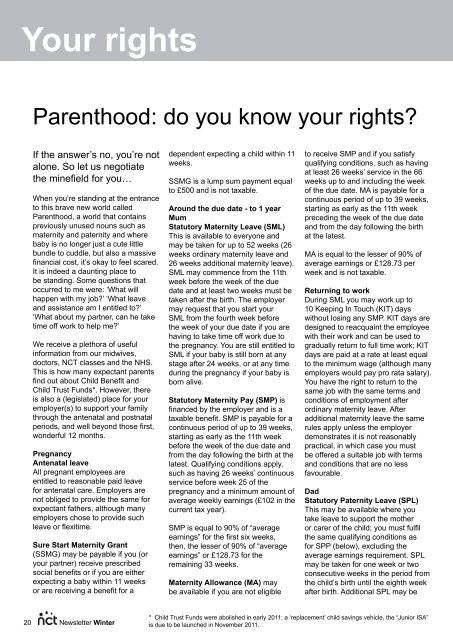Autumn 2011 - Mandy Mazliah
Autumn 2011 - Mandy Mazliah
Autumn 2011 - Mandy Mazliah
You also want an ePaper? Increase the reach of your titles
YUMPU automatically turns print PDFs into web optimized ePapers that Google loves.
Your rights<br />
Parenthood: do you know your rights?<br />
If the answer’s no, you’re not<br />
alone. So let us negotiate<br />
the minefield for you…<br />
When you’re standing at the entrance<br />
to this brave new world called<br />
Parenthood, a world that contains<br />
previously unused nouns such as<br />
maternity and paternity and where<br />
baby is no longer just a cute little<br />
bundle to cuddle, but also a massive<br />
financial cost, it’s okay to feel scared.<br />
It is indeed a daunting place to<br />
be standing. Some questions that<br />
occurred to me were: ‘What will<br />
happen with my job?’ ‘What leave<br />
and assistance am I entitled to?’<br />
‘What about my partner, can he take<br />
time off work to help me?’<br />
We receive a plethora of useful<br />
information from our midwives,<br />
doctors, NCT classes and the NHS.<br />
This is how many expectant parents<br />
find out about Child Benefit and<br />
Child Trust Funds*. However, there<br />
is also a (legislated) place for your<br />
employer(s) to support your family<br />
through the antenatal and postnatal<br />
periods, and well beyond those first,<br />
wonderful 12 months.<br />
Pregnancy<br />
Antenatal leave<br />
All pregnant employees are<br />
entitled to reasonable paid leave<br />
for antenatal care. Employers are<br />
not obliged to provide the same for<br />
expectant fathers, although many<br />
employers chose to provide such<br />
leave or flexitime.<br />
Sure Start Maternity Grant<br />
(SSMG) may be payable if you (or<br />
your partner) receive prescribed<br />
social benefits or if you are either<br />
expecting a baby within 11 weeks<br />
or are receiving a benefit for a<br />
dependent expecting a child within 11<br />
weeks.<br />
SSMG is a lump sum payment equal<br />
to £500 and is not taxable.<br />
Around the due date - to 1 year<br />
Mum<br />
Statutory Maternity Leave (SML)<br />
This is available to everyone and<br />
may be taken for up to 52 weeks (26<br />
weeks ordinary maternity leave and<br />
26 weeks additional maternity leave).<br />
SML may commence from the 11th<br />
week before the week of the due<br />
date and at least two weeks must be<br />
taken after the birth. The employer<br />
may request that you start your<br />
SML from the fourth week before<br />
the week of your due date if you are<br />
having to take time off work due to<br />
the pregnancy. You are still entitled to<br />
SML if your baby is still born at any<br />
stage after 24 weeks, or at any time<br />
during the pregnancy if your baby is<br />
born alive.<br />
Statutory Maternity Pay (SMP) is<br />
financed by the employer and is a<br />
taxable benefit. SMP is payable for a<br />
continuous period of up to 39 weeks,<br />
starting as early as the 11th week<br />
before the week of the due date and<br />
from the day following the birth at the<br />
latest. Qualifying conditions apply,<br />
such as having 26 weeks’ continuous<br />
service before week 25 of the<br />
pregnancy and a minimum amount of<br />
average weekly earnings (£102 in the<br />
current tax year).<br />
SMP is equal to 90% of “average<br />
earnings” for the first six weeks,<br />
then, the lesser of 90% of “average<br />
earnings” or £128.73 for the<br />
remaining 33 weeks.<br />
Maternity Allowance (MA) may<br />
be available if you are not eligible<br />
to receive SMP and if you satisfy<br />
qualifying conditions, such as having<br />
at least 26 weeks’ service in the 66<br />
weeks up to and including the week<br />
of the due date. MA is payable for a<br />
continuous period of up to 39 weeks,<br />
starting as early as the 11th week<br />
preceding the week of the due date<br />
and from the day following the birth<br />
at the latest.<br />
MA is equal to the lesser of 90% of<br />
average earnings or £128.73 per<br />
week and is not taxable.<br />
Returning to work<br />
During SML you may work up to<br />
10 Keeping In Touch (KIT) days<br />
without losing any SMP. KIT days are<br />
designed to reacquaint the employee<br />
with their work and can be used to<br />
gradually return to full time work; KIT<br />
days are paid at a rate at least equal<br />
to the minimum wage (although many<br />
employers would pay pro rata salary).<br />
You have the right to return to the<br />
same job with the same terms and<br />
conditions of employment after<br />
ordinary maternity leave. After<br />
additional maternity leave the same<br />
rules apply unless the employer<br />
demonstrates it is not reasonably<br />
practical, in which case you must<br />
be offered a suitable job with terms<br />
and conditions that are no less<br />
favourable.<br />
Dad<br />
Statutory Paternity Leave (SPL)<br />
This may be available where you<br />
take leave to support the mother<br />
or carer of the child; you must fulfil<br />
the same qualifying conditions as<br />
for SPP (below), excluding the<br />
average earnings requirement. SPL<br />
may be taken for one week or two<br />
consecutive weeks in the period from<br />
the child’s birth until the eighth week<br />
after birth. Additional SPL may be<br />
20 Newsletter Winter<br />
* Child Trust Funds were abolished in early <strong>2011</strong>; a ‘replacement’ child savings vehicle, the “Junior ISA”<br />
is due to be launched in November <strong>2011</strong>.





